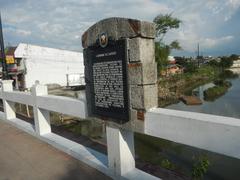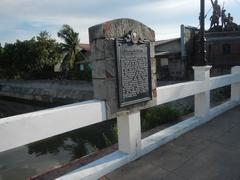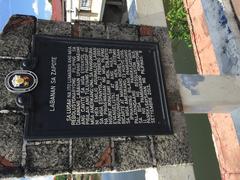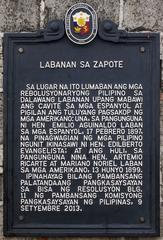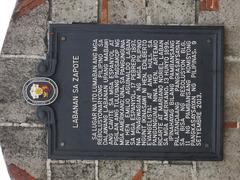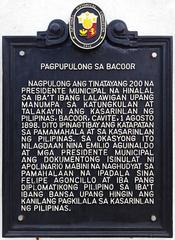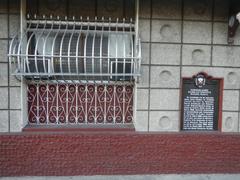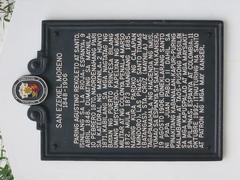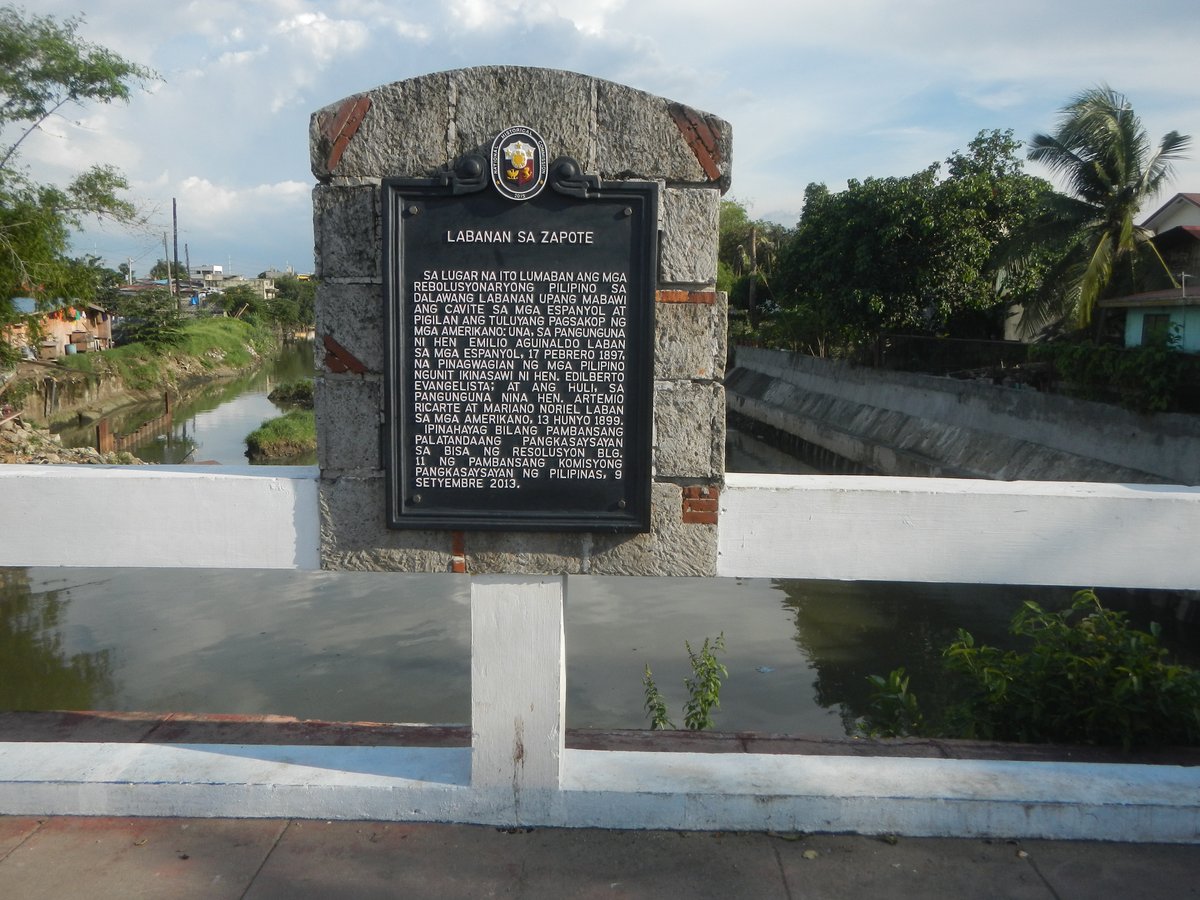
Battle of Zapote Historical Marker: Visiting Hours, Tickets, and Visitor Guide – Bacoor, Philippines
Date: 14/06/2025
Introduction
The Battle of Zapote Historical Marker, situated on the boundary of Bacoor, Cavite, and Las Piñas in Metro Manila, stands as a powerful symbol of Filipino courage and the enduring quest for independence. This historical site commemorates two pivotal confrontations: the 1897 Battle of Zapote Bridge during the Philippine Revolution against Spain and the 1899 battle in the Philippine–American War. Today, visitors can explore preserved remnants of the original stone-arch bridge, interpretive markers, and evocative monuments—many crafted by the renowned sculptor Eduardo Castrillo. These features tell the story of a nation’s resilience and its people’s sacrifices for freedom.
Open daily and free of charge, the site is designed to be accessible to all, including persons with disabilities. Its integration with local heritage trails, nearby attractions, and commemorative events makes it an ideal destination for history enthusiasts, students, and tourists. This comprehensive guide provides essential visitor information, historical context, travel tips, and recommendations to help you make the most of your visit. For more details, see the official sites of the National Historical Commission of the Philippines (NHCP), Bacoor City Tourism, and Wikipedia: Zapote Bridge.
Table of Contents
- Introduction
- Historical Context of the Battle of Zapote
- The Zapote Bridge Historical Marker: Location, Design, and Preservation
- Cultural and National Significance
- Impact on Local Identity and Heritage Tourism
- Practical Information for Visitors
- Visitor Experience and Activities
- Nearby Attractions and Amenities
- Site Conditions and Safety Tips
- Frequently Asked Questions (FAQs)
- Conclusion and Recommendations
- References
Historical Context of the Battle of Zapote
Twin Battles at Zapote Bridge
The Zapote Bridge witnessed two significant battles in Philippine history:
-
Battle of Zapote Bridge (1897): On February 17, 1897, Filipino revolutionaries led by General Emilio Aguinaldo defended the bridge against Spanish forces. General Edilberto Evangelista, a Belgian-trained engineer and key defense strategist, was killed in action, becoming a symbol of valor (Wikipedia: Battle of Zapote Bridge (1897)).
-
Battle of Zapote Bridge (1899): On June 13, 1899, during the Philippine–American War, Filipino forces led by Generals Artemio Ricarte, Mariano Noriel, and Guillermo Masangkay confronted American troops under General Henry W. Lawton. Despite heavy resistance and casualties, the Americans eventually captured the bridge, but the battle demonstrated Filipino determination (Wikipedia: Battle of Zapote River).
The Bridge as a Symbol of Resistance
Constructed in 1817, the Zapote Bridge’s strategic location made it vital for controlling access between Cavite and Manila. In both battles, defenders used the bridge’s architecture to their advantage, even destroying sections to hinder enemy advances. The bridge remains a silent witness to the Filipino people’s struggle for sovereignty (NHCP: The Other Battle of Zapote).
The Zapote Bridge Historical Marker: Location, Design, and Preservation
Placement and Physical Features
The historical marker is located at the restored pedestrian section of the original Zapote Bridge, now serving as a promenade between Bacoor and Las Piñas. Monument parks anchor both ends of the bridge. On the Las Piñas side stands a monument by Eduardo Castrillo, and on the Bacoor side, a monument erected by the Philippine Tourism Authority (Villar Foundation). The marker itself is a cast-iron or bronze plaque, with inscriptions in both Filipino and English.
Restoration and Preservation Efforts
After the destruction caused by the wars, only part of the original bridge survived. Restoration projects funded by local government units and national agencies have preserved its masonry, transformed it into a pedestrian walkway, and maintained its role as a historical park. Ongoing preservation includes site development, retrofitting, and plans for further river management (Manila Bulletin).
Cultural and National Significance
Honoring Heroism and Sacrifice
The marker honors the bravery of Filipino revolutionaries, including General Evangelista and Generals Ricarte, Noriel, and Masangkay. Annual commemorations on February 17 and June 13 draw descendants, historians, and patriots (Bacoor City News).
Educational Value
The site serves as an outdoor classroom. Schools organize field trips, and the Zapote River Walk features mural panels telling the story of the battles (Bacoor City Tourism).
Venue for Commemorations and Community Events
The marker is central to public events, including historical reenactments and parades, especially during significant anniversaries (Villar Foundation).
Impact on Local Identity and Heritage Tourism
Strengthening Bacoor’s Historical Identity
The marker is part of a network of heritage sites that reinforce Bacoor’s place in Philippine history, alongside Bahay Tisa and St. Michael the Archangel Parish (Trip the Islands).
Boosting Tourism and the Local Economy
As a free and accessible destination, the site attracts day-trippers from Manila and supports local businesses. The Bacoor tourism office provides maps and guided tours (Bacoor City Tourism).
Integration with Urban Development
The Zapote River Walk and Bike Lane enhance the visitor experience while supporting local sustainability and wellness initiatives (Bacoor City Tourism).
Practical Information for Visitors
Location and Accessibility
- Address: Adjacent to Aguinaldo Highway, Barangay Zapote, Bacoor, Cavite; links to Las Piñas, Metro Manila.
- Getting There: Jeepneys and buses from Manila stop near the bridge; parking is available but limited (Handsonparentwhileearning.com).
- Accessibility: Wheelchair-friendly pedestrian walkways and ramps.
Visiting Hours and Tickets
- Hours: Open daily, 6:00 AM – 6:00 PM (recommended for safety and comfort).
- Admission: Free; no tickets required.
Guided Tours and Educational Visits
- Tours: Guided tours can be arranged through the Bacoor City Tourism Office; advance booking is recommended, especially for groups and schools.
Visitor Tips
- Best time to visit: Dry season (November–May); early mornings or late afternoons.
- Combine with nearby sites: Bahay Tisa, Bacoor Cathedral, St. Michael the Archangel Parish.
- Amenities: Shaded seating, food stalls, nearby eateries, and convenience stores. Restrooms available in nearby commercial areas.
- Safety: Exercise caution near busy roads and the riverbank; keep personal belongings secure.
Visitor Experience and Activities
- Self-Guided Walking Tour: Explore the bridge, monuments, and marker; the tour takes about 30–60 minutes.
- Photography: Excellent opportunities in the morning or late afternoon.
- Educational Field Trips: Popular for schools; educational panels and murals enhance learning.
Nearby Attractions and Amenities
- Historical Sites: Bahay Tisa, St. Michael the Archangel Parish, Aguinaldo Shrine in Kawit (NHCP Aguinaldo Shrine), Las Piñas Bamboo Organ.
- Food: Local carinderias, fast food chains, and coffee shops nearby. Bacoor’s tahong (mussels) and pancit are recommended.
- Souvenirs: Local markets and shops offer crafts and snacks.
Site Conditions and Safety Tips
- The site and monuments are well-maintained, though occasional river odors may be present—face masks can help.
- The area is generally safe, but exercise caution near the riverbank and busy roads.
- No on-site restrooms; nearby businesses offer facilities.
Frequently Asked Questions (FAQs)
Q: What are the visiting hours for the Battle of Zapote Historical Marker?
A: Open daily, 6:00 AM – 6:00 PM (recommended).
Q: Is there an entrance fee?
A: No, admission is free.
Q: Are guided tours available?
A: Yes, arrange in advance through Bacoor City Tourism Office.
Q: Is the site wheelchair accessible?
A: Yes, with paved walkways and ramps.
Q: Can I take photos?
A: Yes, photography is encouraged.
Q: Are there restrooms?
A: No restrooms on-site, but nearby establishments have facilities.
Q: Are there amenities nearby?
A: Yes, eateries and stores are within walking distance.
Q: Is the site safe for children and families?
A: Yes, but supervise children, especially near the river and roads.
Visuals and Media
- Include images of the Zapote Bridge, monuments, and murals to enhance your guide.
- Recommended alt text: “Zapote Bridge historical marker Bacoor Cavite,” “Eduardo Castrillo monument Zapote,” “Battle of Zapote site Bacoor.”
References
- Lost With Zii’s Bacoor City feature
- Villar Foundation – Historical Zapote Bridge
- Handsonparentwhileearning.com – Battle of Zapote Bridge Monuments
- Schadow1 Expeditions – Cavite Historical Sites
- Kurby.ai – Best Tourist Attractions in Bacoor
Conclusion and Recommendations
The Battle of Zapote Historical Marker is a must-visit for anyone passionate about Philippine history and heritage. As a National Historical Landmark, it offers a tangible link to the nation’s revolutionary past, honoring the heroism of Filipino revolutionaries and fostering a deeper understanding of the country’s journey toward independence. With its accessible location, free admission, and integration with Bacoor’s vibrant heritage network, the site promises an enriching experience for all visitors.
Plan your visit during the dry season, take advantage of guided tours, and explore other nearby attractions to create a comprehensive and memorable historical journey. For more information, consult official resources from the NHCP and Bacoor City Tourism.
For travel tips, interactive maps, and updates on historical sites, download the Audiala app and connect with us on social media. Make your journey into Philippine history both meaningful and unforgettable!

